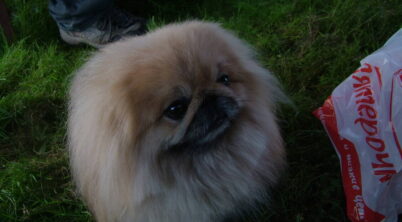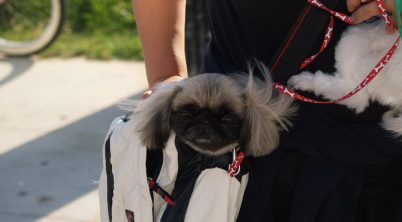The Pekingese is a small dog breed with a long history and a bold appearance. Many people wonder about the strength of its jaw and how powerful its bite really is. The bite force of a Pekingese is considered modest, usually much lower in pounds per square inch (PSI) than larger breeds.
Even with its small size, the Pekingese has a unique jaw structure and strong teeth for its size. While its bite pressure is not likely to cause serious harm, understanding the breed’s bite force can help owners handle and train their dogs safely. Anyone interested in the Pekingese or thinking about getting one will benefit from knowing more about its bite force and how it compares to other dogs.
Table of Contents
Understanding Pekingese Bite Force
Pekingese are small dogs, but their bite force is a common topic of interest. To understand their bite power, it is helpful to look at how bite force is measured, how they compare with other breeds, and what their jaw structure means for their bite.
What Is Bite Force and PSI Measurement
Bite force is the amount of pressure a dog’s jaws can create when biting down. It is measured in pounds per square inch (PSI). PSI shows how much force is applied in a small area.
Researchers test bite force by having dogs bite on a special device that measures PSI. Large breeds like the Kangal can have bite forces up to 743 PSI, while most dogs have much lower numbers. Even small dogs, like the Chihuahua, show bite forces between 100 and 180 PSI.
The Pekingese bite force is usually between 100-200 PSI. This number is enough to break skin and cause discomfort if they bite, but it is not as high as larger breeds. Knowing PSI can help owners understand a dog’s potential for causing injury.
Pekingese Bite Force Compared to Other Breeds
The Pekingese sits on the lower end of the dog bite force chart. For comparison, see the table below:
| Breed | Bite Force (PSI) |
|---|---|
| Kangal | 743 |
| English Mastiff | 556 |
| Rottweiler | 328 |
| German Shepherd | 238 |
| American Bulldog | 305 |
| American Bandogge | 730 |
| Pekingese | 100-200 |
| Chihuahua | 100-180 |
Very strong breeds, like the Kangal and American Bandogge, can cause more damage with a single bite due to their high bite force. The Pekingese has about the same bite force as a Chihuahua; both are much weaker than large dogs like the Rottweiler. Still, even “smaller” dog bite forces can hurt, especially if they bite a sensitive area.
Jaw Structure and Muzzle Shape
The Pekingese is recognized for its short muzzle and flat face, a shape called brachycephalic. This jaw structure impacts how the dog bites. Their jaws are strong for their size, but they are shorter and flatter than those of dogs like German Shepherds or Rottweilers.
A Pekingese’s wide jaws create a unique bite, but the short muzzle limits the strength and reach of their bite. Dogs with longer muzzles, like the Kangal and Mastiff, can exert more force because of their bigger jaw muscles and longer leverage.
The Pekingese’s teeth are closely set, which makes their bites focused in a small area. This can still cause pain or injury, especially if the dog feels threatened. Their jaw structure makes them less likely to have the “strongest bite” but it suits their small size and companion lifestyle.
Biting Behavior and Temperament of the Pekingese
The Pekingese, also known as the “lion dog” or “Chinese Spaniel,” has a gentle demeanor but may show biting behavior in certain situations. Their loyalty, independence, and social needs influence how they react in their home and around others.
Common Triggers for Biting
Pekingese dogs are small but alert. They may bite when startled, threatened, or experiencing fear. Common triggers include sudden movements, rough handling, or new people invading their space. Children should be taught to approach them carefully, as the breed can react quickly if they feel uncomfortable.
Protective instincts are strong in the Pekingese. This breed, sometimes used as a small guard dog, will often bark or snap to protect its owner. Some individuals may nip when food is present due to resource guarding. While not aggressive by nature, they may also bite if pain from illness or injury is ignored. Understanding their body language helps prevent these reactions.
Temperament and Independence
Pekingese dogs are well known for their independence and strong personalities. While they often bond closely with their owners, they value personal space. High affection levels are paired with a need to control their own environment.
Their loyalty is clear, but they may resist too much handling, especially from strangers. The “peke” is not typically a high-energy wanderer, but a moderate impulse to explore or chase small animals can appear, reflecting their prey drive.
Despite their small size, Pekingese are confident and not easily intimidated. Socialization from an early age helps them become well-rounded adults who cope better with new situations and reduce the chances of unwanted biting behavior.
Training and Socialization for Bite Prevention
Preventing biting incidents with a Pekingese takes consistent training, social exposure, and careful management. Owners should start these steps early to shape gentle behavior and support good relations with both people and other pets.
Bite Inhibition Training and Techniques
Bite inhibition training is the process of teaching a dog how to control the strength of its bite. For the Pekingese, this step is vital, even though its bite force measures only around 100-200 PSI. This training begins in puppyhood, when biting during play is common.
Owners should provide feedback if the dog bites too hard, such as a sharp “ouch,” and stop play for a few moments. This response helps the dog learn that gentle mouths get rewards, while hard bites end fun.
It’s also helpful to provide plenty of safe chew toys. These can redirect biting from hands or clothes. Over time, using these simple techniques decreases the risk of unwanted biting incidents.
Positive Reinforcement Methods
Positive reinforcement is a key strategy for training Pekingese dogs. These dogs respond best to reward-based training, where good behavior is followed by treats, praise, or extra playtime. For bite prevention, owners should reward the dog every time it shows a gentle mouth or plays nicely.
Training sessions should be short but frequent, as Pekingese have moderate to low trainability and may lose focus quickly. Avoid punishment, which can increase fear or aggression leading to more dog bites.
A table of simple rewards:
| Desired Behavior | Reward |
|---|---|
| Gentle play | Small treat |
| No biting when excited | Extra petting |
| Calm greeting | Verbal praise |
Keeping training positive helps build trust and reduces resistance.
Socialization and Behavioral Development
Socialization has a strong impact on biting prevention and general adaptability. A well-socialized Pekingese is less likely to act out of fear. Early social exposure to new people, animals, and environments helps the dog learn proper ways to interact, even in busy settings like apartments.
Introducing the dog to calm dogs, supervised children, and different noises can lower watchdog tendencies and anxiety. Owners should satisfy the breed’s social needs since these dogs do not tolerate long alone times well and may react negatively if lonely or scared.
Structured play, gentle introductions, and ongoing exposure are all necessary for healthy behavioral development and fewer biting incidents.
Physical Characteristics and Breed Profile
The Pekingese is a small companion dog known for its unique look and background. This dog breed is compact but sturdy, featuring a distinct coat and personality traits that appeal to many families.
Size, Weight, and Height Statistics
Pekingese are a toy breed, meaning they are small in size but strong for their build. Average weight falls between 7 and 14 pounds (3–6 kg). Most stand 6 to 9 inches (15–23 cm) tall at the shoulder, making them well-suited for small homes and apartments.
They are classified as a toy breed by major kennel clubs. Despite their size, they have a solid frame and walk with a confident gait. Pekingese are purebred dogs with a long history as royal companions in China.
Because of their compact size, they are adaptable to urban living. However, their stocky bodies make them less athletic compared to larger breeds.
Grooming and Appearance
The Pekingese is easily recognized by its long, flowing double coat that covers the body, head, and even feet. Regular grooming is required to prevent mats and keep the coat healthy. Brushing several times a week is needed, and many owners consider professional grooming.
A hallmark of their appearance is their flat face, short nose, and large, dark eyes. Their mane-like fur around the neck creates a lion-like look. Common colors include gold, red, white, cream, and black. Most Pekingese have a thick undercoat that helps them tolerate cold better than heat, but they can easily become overheated in hot weather.
Grooming routines should include eye care and cleaning facial folds. Shedding is moderate to high, so regular maintenance is important for those with allergies.
Breed Popularity, Availability, and Price
The Pekingese has a long history as a companion dog and remains popular with families and older adults. In the United States, it usually ranks in the lower half among dog breeds for popularity according to the American Kennel Club.
They are available from reputable breeders, breed-specific rescues, and sometimes through general adoption. Most purebred Pekingese puppies cost between $400–$3,000 USD, depending on pedigree, breeder reputation, and location.
Availability can be limited in some areas, especially for show-quality dogs. The breed is valued for loyalty, independence, and its unique appearance, appealing to people who are looking for a small but bold companion.
Health Considerations and Veterinary Care
Pekingese dogs need regular veterinary care and attention to their health to maintain their well-being. Understanding their typical health issues and what affects their bite force can help owners keep their pets safe and healthy.
Typical Health Concerns of Pekingese
Pekingese dogs often face several health concerns throughout their lives. Brachycephalic syndrome is common due to their short snouts, leading to breathing problems. They are also prone to dental issues, which can impact their bite strength and jaw health.
Other common problems include eye disorders such as corneal ulcers and progressive retinal atrophy. Allergies and skin infections can cause discomfort, and joint issues like patellar luxation may affect movement.
Routine veterinary check-ups are important. Veterinarians can catch early signs of these issues, recommend care strategies, and assess the dog’s mouth during check-ups to ensure dental health and monitor for any bite-related problems. Early intervention can help increase both lifespan and quality of life.
Factors Influencing Bite Force and Safety
The bite force of a Pekingese is not just about jaw strength. Several factors play a role, such as the dog’s size, jaw structure, and overall health status. Dental problems can weaken bite force, and age may lead to less jaw muscle strength.
Pekingese usually have a low mouthing tendency and are not known for frequent biting incidents. However, pain, fear, or stress can cause them to bite. Their small size means their bite force is lower than many larger breeds, but caution is still necessary around children and strangers.
Understanding bite risk is key for safety. Regular veterinary care helps track dental and jaw health. Monitoring behavior for changes, such as increased barking frequency or irritation, can alert owners to potential problems before they lead to bites or aggression.








